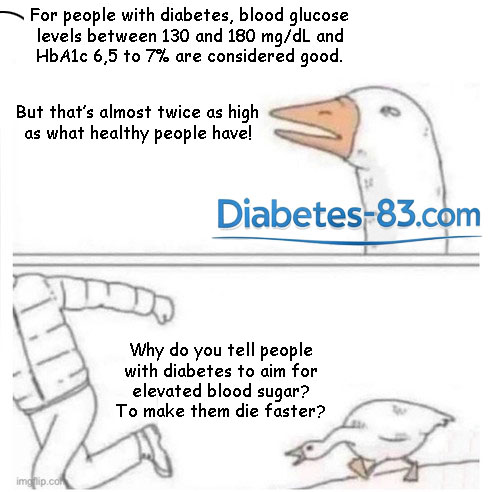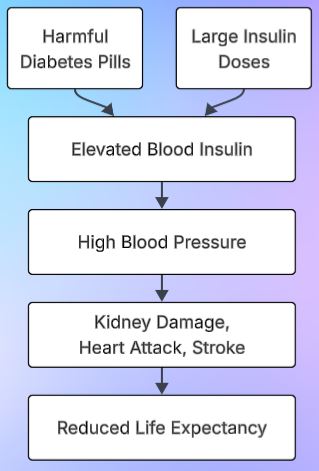One of the key premises of this book is that the officially recommended blood glucose targets for people with diabetes, both adults and children, are set too high. Following these targets puts patients at serious risk for long-term complications, including disability and premature death. To become and stay healthy, diabetics must aim for blood sugar levels that match those of people without diabetes.

Individuals with diabetes should know the typical blood glucose levels found in healthy adults and children. Surprisingly, this information is not readily accessible. It seems to be deliberately overlooked by organized medicine. There is a deliberate effort to keep this knowledge hidden from the public. However, Dr. Bernstein conducted extensive research and uncovered these crucial numbers. On Dr. Bernstein’s page you can learn more about how he did it.
In healthy individuals, blood sugar stays within the following ranges almost 24 hours a day:
- Children before puberty: 65–81 mg/dL
- Teenagers and adults: 75–91 mg/dL
Dr. Bernstein left a legacy for people with diabetes following a low-carbohydrate system to control their disease: treat a blood sugar level of 83 mg/dL as sacrosanct. It sits in the middle of the healthy range for adults and adolescents.
Healthy Blood Glucose and Glycated Hemoglobin Levels
The officially endorsed target range for glycated hemoglobin (HbA1C) in adults and children with diabetes is 6.5-7%. It corresponds to an average blood glucose level of 140-154 mg/dl. However, in healthy non-obese adults, blood glucose levels typically hover around 83 mg/dl. When measuring blood glucose levels in healthy adults, they may temporarily appear higher, like 140-154 mg/dl, only if the individual has recently consumed a substantial amount of carbohydrates.
An average blood glucose level of 83 mg/dl over the past 2-3 months corresponds to a glycated hemoglobin level of 4.5%. Individuals who follow a low-carbohydrate system to control their diabetes should strive for a glycated hemoglobin blood test result ranging from 4.4% to 4.7%. In the context of this analysis, you can consider satisfactory HbA1C levels of 4.8% to 5.1%. However, if your result exceeds 5.1%, it is advisable to focus on improving diabetes control.
Post-Meal Blood Sugar Spikes
In healthy individuals, blood sugar levels may temporarily increase to 140-154 mg/dL after consuming a high-carbohydrate meal. Based on such observations, official medicine says it is acceptable and desirable for diabetic patients to continuously maintain their blood glucose levels of 140-154 mg/dL. However, in healthy adults and children, such elevations are short-lived, lasting for 15-20 minutes at most. These transient spikes in blood glucose don’t usually lead to the development of diabetes complications. In adults with normal metabolism, blood sugar levels rapidly return to normal, around 83 mg/dL, after meals.
Unlike healthy individuals, people with diabetes face challenges in effectively lowering their blood glucose levels to normal ranges. Excessive use of insulin and blood sugar-lowering medications can lead to severe hypoglycemia. Therefore, individuals with diabetes should focus on preventing significant increases in their blood sugar after meals and in other situations. You can accomplish it by following a low-carbohydrate diet and implementing the other recommendations provided in this book.
Normal Blood Glucose Levels For Children
In children before puberty, typical blood glucose levels are slightly lower compared to adults, averaging around 73 mg/dL. It corresponds to glycated hemoglobin of 4.2%. It is worth noting that the officially recommended blood glucose targets are the same for both adults and children with diabetes. For children, they are twice the healthy blood glucose level.
Adhering to the officially recommended protocols for treating diabetes in children can result in issues such as stunted growth and increased susceptibility to infections. Complications related to the eyes, legs, kidneys, and other body parts are typically not evident during childhood but become more pronounced in early adulthood.
Why Official Blood Sugar Targets Are Higher Than Normal
Official medical guidelines discourage people with diabetes from aiming to achieve blood sugar levels equivalent to those of healthy individuals. There are two primary reasons for this:
- Doctors fear lawsuits from people with diabetes who have suffered severe hypoglycemia.
- Some studies claim that striving for normal blood sugar levels offers no benefit in diabetes.
The sections below examine and refute both arguments in detail.
The Dangers of Severe Hypoglycemia
The healthy blood glucose targets may allegedly increase the risk of severe hypoglycemia. It can result in irreversible brain damage or even death. Lawsuits from patients who have experienced it or their relatives could bankrupt doctors.
However, diabetics who manage their condition through a low-carbohydrate system have shown a significantly reduced risk of severe hypoglycemia. They don’t take potentially harmful medications that can trigger hypoglycemia. After transitioning to a low-carbohydrate diet, the required insulin doses drop by a factor of 2 to 8. It contributes to more stable insulin action and decreases the risk of hypoglycemia.

If you want to live a long and healthy life without disabilities, take the information at this page very seriously. Adhering to the officially recommended high blood glucose targets for adults and children with diabetes is dangerous. It can significantly shorten the lifespan of people with diabetes. Also, it can cause them to suffer before they pass away from problems like blindness, leg issues, and kidney complications.
Evidence from Clinical Trials
In the 2000s, several major clinical trials claimed that people with type 2 diabetes should avoid lowering their glycated hemoglobin below 6.5%. In other words, they advised against keeping blood sugar consistently below 140 mg/dL. The key studies are listed below:
- ACCORD – Action to Control Cardiovascular Risk in Diabetes.
- ADVANCE – Action in Diabetes and Vascular Disease.
- VADT – Veterans Affairs Diabetes Trial.
To gather reliable data, a trial must include many participants and follow them for several years. All the studies listed above met these criteria. They enrolled between 1,800 and 11,000 people with type 2 diabetes and tracked their health for at least four years—often even longer.
Researchers divided the trial participants into two groups:
- An intensive diabetes control group with a target glycated hemoglobin level of 6.5–6.9%.
- A standard treatment group with higher hemoglobin targets and less strict control.
In all three trials, intensive diabetes control increased the risk of severe hypoglycemia. In the ACCORD study, it even raised the death rate among patients who managed their disease more aggressively.
Many authors of medical journal articles about these trials claim that trying to normalize blood sugar in diabetes is pointless or even harmful. But they are wrong. The problem wasn’t the outcomes—it was the methods used to lower blood glucose levels in the participants.
Normal Blood Sugar, Abnormal Results: What Went Wrong?
In all the trials, doctors probably advised people with diabetes to follow a standard diet that is high in carbohydrates. Back in the 2000s, it was common for doctors to discourage low-carb diets, often warning about potential kidney damage. Today, organized medicine has become more open to low-carb approaches for managing diabetes. Read more about it here.
When following a standard high-carbohydrate diet, there are only a few ways to lower blood sugar:
- Intensive physical exercise.
- High doses of insulin.
- Powerful medications that the low-carb religion for people with diabetes views as harmful.
In reality, most people with type 2 diabetes are not willing to engage in the intense physical exercise needed to offset the effects of a high-carbohydrate diet. They are doing the right thing by avoiding it. Strenuous exercise can be dangerous, especially for those at risk of heart disease. The risk of a heart attack during such activity is real and significant.
With exercise off the table, the remaining options for lowering blood sugar are high doses of insulin and powerful toxic medications. Both come with serious downsides, which you can read about below.
The Hidden Risks of Potent Diabetes Medications and High-Dose Insulin
The harmful, potent diabetes pills mentioned here are drugs that force the pancreas to produce more insulin. Both high-dose insulin injections and these pills raise insulin levels in the blood. It leads to weight gain and causes the body to retain excess fluid. Obesity and excess fluid retention raise blood pressure. The higher pressure speeds up the risk of heart attacks and strokes. It also damages the kidneys.

Harmful pills and high-dose insulin injections also raise the risk of severe hypoglycemia, which can trigger a heart attack or stroke. Because of these dangers, studies showed that mortality did not decrease among participants who tried to control their type 2 diabetes tightly.
Gliclazide: An Example of Harmful Diabetes Drugs
In the ADVANCE trial, intensive diabetes control involved taking high doses of gliclazide tablets. After several years, patients in this group experienced similar death rates and complications as those who lived with higher blood sugar levels.
The doctors and medical officials involved in the study should have concluded that gliclazide is ineffective, if not harmful. Instead, they wrote in many articles and reports that trying to normalize blood sugar in diabetes by any means is a bad idea.
Benefits of the Low-Carb Diet Approach
The diabetes management system based on a low-carb diet relies on low-dose insulin injections and completely avoids harmful pills. After switching to a low-carb diet, insulin requirements drop by at least half, often by 4 to 5 times, and sometimes up to 7 times. It reduces the body’s drive to store fat, retain excess fluid, and raise blood pressure.
To my knowledge, no large-scale studies have yet examined how switching to a low-carb diet affects mortality and complications in diabetes. However, hundreds of detailed and trustworthy patient reviews—from people with both type 1 and type 2 diabetes—showcase the remarkable benefits of a low-carb diet.
Please note that most online reviews come from people with diabetes who have lowered their glycated hemoglobin to 6.0–7.0%. It means their blood sugar remains higher than that of healthy people. These patients make an error of underestimating their long-term risk of developing chronic diabetes complications. To protect your precious eyes, legs, and kidneys, aim to bring your blood glucose down to healthy levels. You can learn here how to do it.